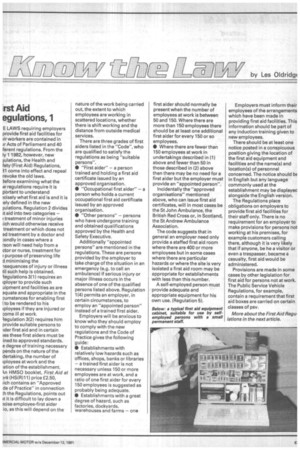rst Aid egulations, 1
Page 41

If you've noticed an error in this article please click here to report it so we can fix it.
E LAWS requiring employers provide first aid facilities for :ir workers are contained in ir Acts of Parliament and 40 ferent regulations. From the ly 1 1982, however, new julations, the Health and fety (First Aid) Regulations, 31 come into effect and repeal revoke the old laws.
3efore examining what the vy regulations require it is portant to understand
.cisely what first aid is and it is :ely defined in the new julations. Regulation 2 divides A aid into two categories — :treatment of minor injuries doh would otherwise receive treatment or which does not ad treatment by a doctor and ondly in cases where a rson will need help from a ctor or nurse, treatment for purpose of preserving life
d minimising the
isequences of injury or illness til such help is obtained. legulations 3(1) requires an iployer to provide such Jipme nt and facilities as are equate and appropriate in the umstances for enabling first Ito be rendered to his
iployees if they are injured or 2ome ill at work.
legulation 3(2) requires him provide suitable persons to ider first aid and in certain ies these first alders must be ined to approved standards.
e degree of training necessary pends on the nature of the dertaking, the number of iployees at work and the .ation of the establishment. kn HMSO booklet, First Aid at )rk (HS(R)11) price €2.50, lich contains an "Approved de of Practice" in connection :h the Regulations, points out it it is difficult to lay down a 3cise employee-first aider io, as this will depend on the nature of the work being carried out, the extent to which employees are working in scattered locations, whether there is shift working and the distance from outside medical services.
There are three grades of first eiders listed in the "Code", who are qualified to satisfy the regulations as being "suitable persons".
• "First eider" — a person trained and holding a first aid certificate issued by an approved organisation.
• "Occupational first aider" — a person who holds a current occupational first aid certificate issued by an approved organisation.
• "Other persons" — persons who have undergone training and obtained qualifications approved by the Health and Safety Executive.
Additionally "appointed persons" are mentioned in the regulations. These are persons provided by the employer to take charge of the situation in an emergency (e.g. to call an ambulance) if serious injury or major illness occurs in the absence of one of the qualified persons listed above. Regulation 1(4) permits an employer, in certain circumstances, to employ an "appointed person" instead of a trained first aider.
Employers will be anxious to know who they should employ to comply with the new regulations and the Code of Practice gives the following guide: • Establishments with relatively low hazards such as offices, shops, banks or libraries — a trained first aider is not necessary unless 150 or more employees are at work, and a ratio of one first eider for every 150 employees is suggested as probably being adequate.
• Establishments with a great degree of hazard, such as factories, dockyards. warehouses and farms — one first aider should normally be present when the number of employees at work is between 50 and 150. Where there are more than 150 employees there should be at least one additional first aider for every 150 or so employees.
• Where there are fewer than 150 employees at work in undertakings described in (1) above and fewer than 50 in those described in (2) above then there may be no need for a first eider but the employer must provide an "appointed person".
Incidentally the "approved organisations" mentioned above, who can issue first aid certificates, will in most cases be the St John Ambulance, the British Red Cross or, in Scotland, the St Andrew Ambulance Association.
The code suggests that in general an employer need only provide a staffed first aid room where there are 400 or more employees but in some cases where there are particular hazards or where the site is very isolated a first aid room may be appropriate for establishments with less than this number.
A self-employed person must provide adequate and appropriate equipment for his own use. (Regulation 5). Employers must inform their employees of the arrangements which have been made in providing first aid facilities. This information should be part of any induction training given to new employees.
There should be at least one notice posted in a conspicuous position giving the location of the first aid equipment and facilities and the name(s) and location(s) of personnel concerned. The notice should bE in English but any language commonly used at the establishment may be displayec alongside the English version.
The Regulations place obligations on employers to provide first aid facilities for their staff only. There is no requirement for an employer to make provisions for persons not working at his premises, for example customers calling there, although it is very likely that if anyone, be he a visitor or even a trespasser, became a casualty, first aid would be administered.
Provisions are made in some cases by other legislation for first aid for persons not at work. The Public Service Vehicle Regulations, for example, contain a requirement that first aid boxes are carried on certain classes of psv.
More about the First Aid Hegu. lations in the next article.










































